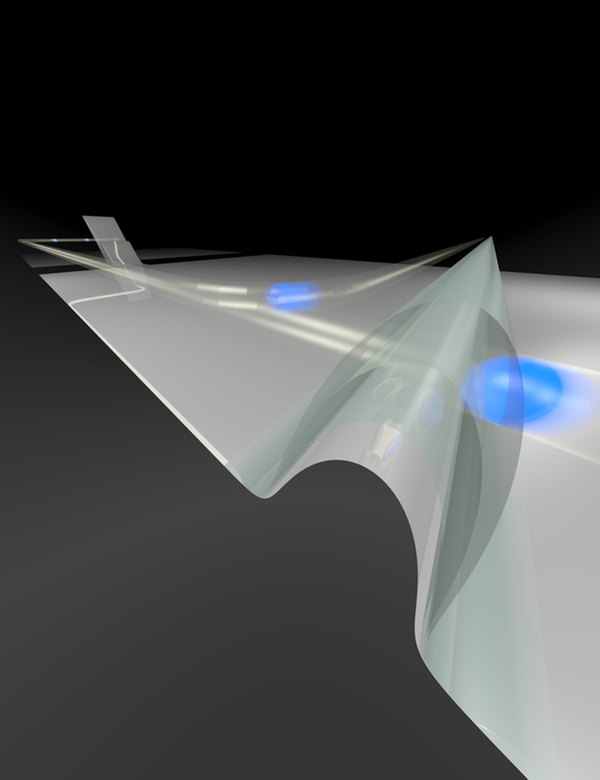Controlling Electrons Reaches a New Level
Semiconductor structures can guide electron motion in versatile ways, so researchers have begun using them to explore the electron’s wavelike, quantum-mechanical nature. But the task is complicated by the constant jostling electrons face in a solid. In Physical Review Letters, researchers describe a way to inject electrons individually with a high energy that makes them easy to distinguish from the others in the semiconductor. The team precisely timed the motion of the injected electrons across a micrometer-sized sample and found that most electrons made the trip without losing energy. If they can also avoid collisions that disrupt their quantum state, these electrons could provide new ways to test fundamental quantum behavior.
Experiments in the field of quantum optics have demonstrated a wide range of quantum behaviors for light. Lately, researchers have begun replicating some of these experiments using the wave nature of electrons in solids, for example, probing the details of the interference between a pair of electrons [1]. Masaya Kataoka of the National Physical Laboratory (NPL) in Teddington, UK, and his colleagues suspected that the experiments would be easier with electrons having energies far above that of thermally excited electrons. But “before we did these experiments, some people told me it’s impossible to detect this, because an electron quickly loses energy” as it travels through a material, says Kataoka. The energy loss was seen in earlier experiments done by others [2].
The NPL team adapted a so-called electron pump structure, developed for use as a current standard, which emits single electrons at a precisely defined rate. Built on a semiconductor surface, the pump includes a set of metal electrodes that surround a tiny circle of semiconductor material. Applying a large enough negative voltage to the electrodes confines electrons to the disk by providing an energy hill, or barrier, to their motion in every direction. This “quantum dot” can hold at most a few electrons, and periodically lowering the barrier on one side of the disk at a microwave frequency liberates one electron in each cycle, which is quickly replenished. By using a dot a few hundred nanometers across, the team generated electrons with thousands of times more energy than typical thermal electrons at the temperatures of their experiments (around kelvin).
Using another electrode micrometers away, the team produced a separate energy barrier that they also caused to oscillate in height. Each pumped electron that reached this distant barrier with enough energy to surmount it contributed a tiny pulse of charge to a detection circuit. The circuit registered a steady current showing the average number of electrons per second. The team measured this current using a range of amplitudes and relative timings for the two oscillating barriers.
Even though the system couldn’t detect single electrons directly, it gave information about single-electron effects. For example, the measured current showed which conditions allowed, during each cycle, a single electron to be released by the pump and then detected beyond the distant barrier. The team found that adding a -tesla magnetic field, which forced electrons to travel along the edge of the sample, allowed most electrons to retain virtually all of their energy during their trip to the distant barrier. But in a -tesla field, more than half of the electrons lost energy. “We don’t fully understand yet” why the strong field reduces the energy loss so much, says Kataoka.
The researchers went further, exploring the precise timing of the electron emission. By changing the relative timing of the oscillating barriers, they deduced that the moment of release from the pump was very well controlled, varying by no more than picoseconds from one cycle to the next. This was unprecedented time resolution for high-energy electrons. While the results don’t yet demonstrate long-lived quantum coherence for high-energy electrons, showing no loss of energy is an essential step toward that possibility.
Gwendal Fève of the École Normale Supérieure in Paris, a member of the team that previously demonstrated interference between pairs of lower-energy electrons, was pleasantly surprised by how long the electrons retain their energy in the new devices. “Their system is quite interesting and very promising,” he says, and the higher energy could make new types of measurement possible.
–Don Monroe
Don Monroe is a freelance science writer in Murray Hill, New Jersey.
References
- E. Bocquillon, V. Freulon, J.- M. Berroir, P. Degiovanni, B. Placais, A. Cavanna, Y. Jin, and G. Feve, “Coherence and Indistinguishability of Single Electrons Emitted by Independent Sources,” Science 339, 1054 (2013)
- D. Taubert et al., “Relaxation of Hot Electrons in a Degenerate Two-Dimensional Electron System: Transition to One-Dimensional Scattering,” Phys. Rev. B 83, 235404 (2011)





